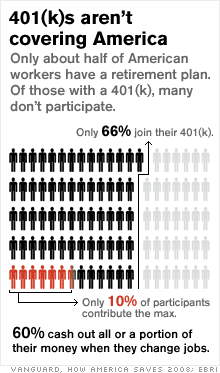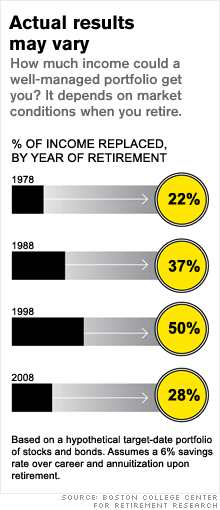It's time to fix the 401(k)
The 401(k) plan can be a powerful savings tool. But for more of us to enjoy a secure retirement, we need a bigger, better idea.



(Money Magazine) -- Alicia Munnell is a Harvard-trained economist. She served as an assistant secretary of the Treasury and is regarded as one of America's foremost experts on 401(k)s. You'd think she'd be terrific at managing her own retirement, but even she has to fess up to some mistakes. "When my son got married, I took some money out of my plan to help," says Munnell, who heads Boston College's Center for Retirement Research (CRR). "And I ended up paying a 10% penalty and taxes."
In the jargon of the retirement business, that's called leakage. It's a common problem: About 60% of job switchers with a 401(k) plan cash it out.
That's just one of the many pitfalls. Lots of people start saving too late, save too little or make missteps with their portfolio. And all of us are vulnerable to risks that we can't control. Your employer might not offer a plan or might choose one with second-rate investments. Or you may hit a market storm at precisely the wrong moment: the year you stop working.
That last problem is especially obvious now. Over the past 12 months, a 64-year-old investor in an age-tailored "target date" mutual fund has lost 26%. Savers with high balances can recover from that. But many lost more, and the typical near-retiree with a 401(k) has less than $50,000 stashed away in it. That will spend down quickly, and once the money's gone, it doesn't matter if the market roars back.
A recent CRR study shows that a bear market retiree could easily end up with just half the income from a 401(k) as someone retiring during a bull market. "Any system that delivers such wild swings in retirement income is just not working," says Munnell.
She isn't the only one who's worried. A growing number of policy experts who study 401(k)s think they fall short. So why not rethink America's retirement system from the ground up? No, it won't be easy: We're in an economic crisis, and lobbyists for the financial services industry will fight like tigers for the status quo. But that doesn't make the task any less urgent. Some 78 million baby boomers are hurtling toward retirement. Their poverty, if it comes to that, will be a burden to their children and lead to calls for taxpayers to support them.
What would a better system look like? It would be universal and strike a more conservative balance of risk and return. Most of all, it would be designed for savers, not employers or money managers. Here are five principles for reform.
Our current retirement system hasn't broken - it was never really a working system to begin with. No law-makers designed the 401(k) to displace the traditional pension, although that's what ultimately happened. It is named for a tax loophole that pension consultants gradually built a plan around. Under the rules, the earnings you put into a 401(k) aren't taxed, and the account grows tax deferred until you cash out at retirement. It's not a cheap program: The tax advantage for 401(k) contributions will cost the Treasury $51 billion in 2009. Add in the break for IRAs, which are largely funded by 401(k) rollovers, and it's $63 billion.
If you are a typical reader of this magazine, that tax break has been extremely valuable for you. Whether it actually encourages you to save more is another matter. Since 401(k)s became more popular, some studies have shown, higher-income people seem to have shifted their assets from taxable to nontaxable accounts rather than saving more.
Lower- and middle-income households, on the other hand, don't benefit as much from the program. They are less likely to be covered by any plan or by one that offers a generous company match. Since they pay lower tax rates, they get less out of the tax deferral. In all, about 70% of the tax benefits for 401(k) savings goes to the top 20% of earners. "Given the way 401(k)s are structured, they are virtually designed to provide inadequate retirement income for the average worker," says University of California Berkeley political scientist Jacob Hacker. So how can the system pull more people in?
Enlisting employers
One obvious approach is to ensure that more people have access to a savings plan through their jobs. This one could be an easy bipartisan compromise. Retirement experts at the conservative Heritage Foundation and the liberal Brookings Institution have together proposed an "automatic IRA." Businesses with no retirement plan would have to put a portion of workers' paychecks into an IRA unless the employee opted out.
Pension experts Pamela Perun and Eugene Steuerle have proposed a simplified retirement plan similar to one in the U.K. Employers would be required to offer a retirement plan with a match of up to 3% of salary. As part of the bargain, the plan would lift some of the burdensome administrative rules of today's 401(k).
Getting a boost from Uncle Sam
A more ambitious approach would be a government savings match similar to what you get from your employer. If this sounds like a subsidy, it is - but then, so is the current tax break. The difference is that this one would take the form of a refundable credit. Unlike tax deferrals, such a credit can benefit even people in low brackets. Gene Sperling, a former Clinton administration official, has proposed a "universal 401(k)" in which low-income workers can get as much as a two-to-one match. Higher-income families may get a 30% match.
Economist Teresa Ghilarducci of the New School for Social Research goes further. To ensure that everyone saves from the start of their career to the end, she proposes a mandatory national savings account on top of Social Security. You'd kick in 2.5% a year and your employer another 2.5%. In one version, the tax credit would be a flat $600 a year for everybody.
Of course, the government can't just throw cash around (recent events notwithstanding). Paying for tax credits would likely mean trimming or eliminating the existing deferrals. Tough sell. No one is talking about touching existing 401(k) balances. But if you are a high earner able to contribute the max to your 401(k), you'd pay more taxes under Ghilarducci's plan. Before you throw out the idea altogether, though, consider this: You weren't always in your current tax bracket. A plan for moderate-income earners could have gotten you saving consistently from the first day of your first job. It could do the same for your kids.
In any retirement system, your standard of living will depend to some extent on the state of the economy. Traditional pensions rely on a financially healthy employer. Even Social Security, as a pay-as-you-go system, depends on the productivity of current workers. But 401(k)s stand out for the way that they concentrate nearly all the economic risk on you alone.
With that risk comes a shot at high rewards. If you have an above-average income, it makes sense to have at least some of your retirement money in the market over your career. But many retirement experts think we need a third tier of savings in between Social Security and the 401(k). It would offer a better return than Social Security but less market risk than mutual funds and other investments. Just a portion of the money you now put into 401(k)s would go here.
Working out the details of this third-tier plan won't be simple. One approach would be to offer a straight-up guarantee. In Ghilarducci's plan, the mandatory savings would go into a single government fund invested in stocks and bonds. You would be guaranteed a payment based on a 3% annual return after inflation, possibly more if the market did so well that the managers decided they could safely distribute extra gains. "Historically, that's a very achievable rate of return," says Ghilarducci. Unfortunately, it is also a modest one - over long periods, stocks have generally beaten inflation by six percentage points or more.
Boston College's Munnell thinks the Dutch retirement system might be a better model. In their national pension fund, retirees get a payment based on their salary and years of service, similar to a company pension. But the amount can change in the event of a severe market crash or funding shortfall. "If returns are low, everyone takes a hit," says Munnell. "Retirees might not get the full cost-of-living adjustment, employers may have to put in more, and workers building up benefits will accrue less."
An American solution would be different in the details. Even so, the basic principle could apply: Spread risk among employers, retirees and current workers and you can smooth out the highs and lows to make some retirement income more predictable.
At the end of your career, a 401(k) will leave you (you hope) with a big pile of money. But stretching those dollars over two or more decades is as big a challenge as accumulating them was.
You face two uncertainties: how markets will perform and how long you will live. Spend too much and you might find yourself a hale and hearty 85-year-old with an empty bank account. One solution is to use at least part of your savings to buy a fixed-rate immediate annuity, which creates a pensionlike income for life. But almost no one does this with their 401(k) balance.
Why? Annuities can be complex - insurance salesmen like them that way - and the expenses are higher for retail investors than for institutions like pension funds. There's also a big psychological barrier: You give up hundreds of thousands of dollars in exchange for a lot of smaller checks. Yet there's evidence that older retirees are happier if they have some annuity income.
A third-tier savings program could provide some guaranteed income. But even without a whole new retirement plan, there are ways to make it easier for retirees to annuitize.
Right now most 401(k)s pay out in a lump sum as a default. It's just less trouble for employers that way. But simply by switching that default to an annuity - or a partial annuity - new retirees would get a signal that this is the smart move. This would also remove some of the hassle and encourage a more competitive annuity market. Experts at Brookings and Heritage recommend automatically converting a portion of a new retiree's 401(k) into a "trial" annuity for just two years. If retirees like getting the regular paychecks, they can convert to a lifetime annuity. "It's a way of letting investors take an annuity for a test drive," says Mark Iwry of Brookings.
Unfair as it sounds, 401(k) plans do not have to fully disclose how much you're being charged. Chances are, it's a lot. "A typical 401(k) plan may be charging participants 1.5% or more annually, when a more reasonable cost would be 0.5% to 1%," says Matthew Hutcheson, an independent pension fiduciary in Portland, Ore. Over 20 years, paying an extra 1% in expenses can reduce your nest egg by about 17%, assuming a 6.5% annual average return.
Low costs would be a key advantage of a public savings plan - in general, the larger the plan, the lower the expenses. In the meantime, though, we could at least set some sensible expense rules for the system we have. Congressman George Miller, head of the House Education and Labor committee, has introduced a bill mandating that plans offer at least one low-cost index fund. That's a great start.
All of these proposals require some public oversight of your retirement investments. But when tax breaks are involved, that's inevitable - your current 401(k) plan is already highly regulated. The task is to make the regulation more effective. To see how the current rules fall short, consider the 2006 Pension Protection Act. It encourages employers to sign people up for 401(k)s automatically and to use target-date retirement funds and other diversified stock-and-bond portfolios as the default investments. Money markets and stable-value funds were mostly ruled out as automatic options.
In other words, the government has already started opining on what is and isn't an appropriate retirement investment. The bill has probably helped steer more savers in the right direction. Even so, the investment guidelines were left quite loose, and different fund companies offered wildly different asset mixes. When the market collapsed last year, investors who happened to be in plans that had nudged them into stock-heavy allocations suffered steep losses.
These are tricky issues. We need a visible public forum to thrash them out, and we ought to be drawing on the advice of the nation's top retirement and investing minds.
So why not create a quasi-independent Federal Retirement Security Board? The members of this "Retirement Fed" should represent a range of backgrounds and points of view - academics, small business owners, workers and money managers. The board's first task would be to set better rules of the road for those default plans and work on standards for expenses. But it could also develop proposals for that crucial third-tier savings plan. Getting retirement right is essential to our nation's economic health. Let's give it the attention it deserves. ![]()


